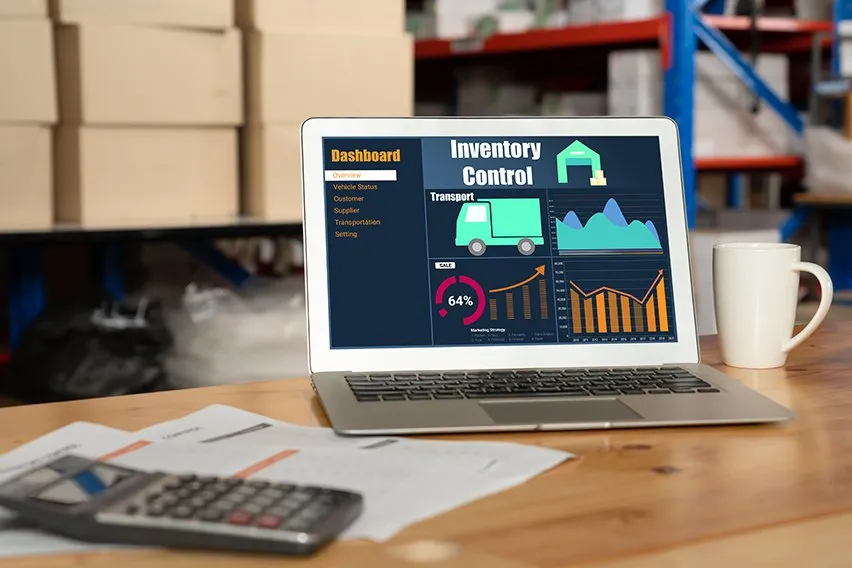What Is Inventory Management? A Guide to Techniques & Methods

Most businesses have an inventory of some kind, and as such, they need to be able to manage it. There are plenty of ways to approach inventory management, but it’s really up to the business. The best way is the management method or technique that suits your company’s inventory. If your business is in need of inventory management systems, look no further! We’re breaking down all of the best techniques in our guide to inventory management.
Here’s What We’ll Cover:
Different Inventory Management Techniques
Benefits of Effective Inventory Management
What is Inventory Management?
Inventory management is the process of ordering, storing, using, and selling the inventory of a business. Depending on the business, this may include raw materials and finished products. It really comes down to the physical inventory items that the business has.
The main purpose of inventory management is to efficiently streamline inventories. There are two major reasons to do this.
- To avoid any shortage of products
- To avoid any excess inventory
In short, inventory management boils down to a balancing act, and the way that items are balanced over time.

Why Do Inventory Levels Need to Be Maintained?
The inability to forecast future demand accurately leads to dead stock and stock shortage. Keeping inventory fresh is important. However, items that are in demand should still be available.
Deadstock, or extra inventory, means that resources are being wasted. These items are not expected to sell, and it means that the business is taking a loss. This is a common problem in companies that deal with perishable products, like restaurants or other food services. It can also indicate that cash flow is reduced, meaning funds are less available.
On the other hand, being short-handed on a product is a large issue as well. If customer demand is high, then the expectation for a product to be in stock is high as well. When items aren’t in the inventory and available for purchase, customer satisfaction tends to suffer. When items are not available, then businesses miss out on potential sales. This is also indicative of a cash flow issue.
So how can dead stock and stock shortages be combated? What are the best ways to keep stock levels at the right amount? Keeping track of inventory is the first step to all great inventory management techniques.
Accounting For Inventory
Generally, inventory is considered to be a current asset to a business. This is because products tend to sell within a short period of time, a year or less in most cases. All inventory must be counted or measured before it can be put on the balance sheet. This is a form of inventory control. Items can be broken down into the following categories:
- Raw materials – The materials products are made from. These are not ready for sale, and undergo significant work or changes before being sold.
- Goods in process – Raw materials in the process of being made into goods. Can also be called “work in process.”
- Finished goods – Completed products that are ready to sell. Can also be called finished products.
- Merchandise – Finished goods that a company buys from a supplier. This is also part of the supply chain management process.
Depending on the company, there are three accounting techniques used in inventory management. They each have their distinct advantages and are normally industry-based.
First In, First Out (FIFO)
This method, as the name implies, pushes the disposal of items that were purchased first. Items purchased first should be used or consumed before items that were purchased more recently. This is an accounting method commonly seen in industries with perishable items. For example, restaurants want to sell their older inventory before it goes bad. If it were to go bad, they’d be losing money on unused products.
Last In, First Out (LIFO)
Alternatively, there is also LIFO. This method is the opposite of FIFO, in that it pushes to dispose or consume the most recently purchased items first. This method is only used in the United States and is governed by the GAAP. It lowers net income but is tax advantageous as prices rise.
Weighted Average
The weighted average method is an accounting method specifically used in manufacturing. It is used to assign the average cost of production to a product. It is used most often when inventory items become so intertwined that costs cannot be assigned to a single unit. This method assumes that all items are being sold at the same time. This is the reason it is used most in the manufacturing industry, where items are sold in bulk.
Different Inventory Management Techniques
The goal of inventory management is to maintain a company’s inventory accurately over time. Inventory that’s purchased is both a liability and an asset. However, the scale tips in one direction depending on the lifespan of the items in question. This is why inventory management is so crucial. Generally speaking, there are two major inventory management methods that are used. There are other models, as well. All are listed below.
The Just-In-Time (JIT) Method
The JIT method originated in Japan in the 1960s and 1970s. The most significant contributor to the development of this method was Toyota. This method focuses on only keeping the inventory necessary to produce and sell products. It cuts inventory costs significantly, saving the company employing the method money overall. It also reduces insurance and storage costs, since there is less product to worry about.
This method increases risk, however. If demand forecasting is off, and demand suddenly spikes, the company may not be able to source the products it needs. This can cause a major disruption in a quick manner. This damages company reputation, and prevents the company from keeping customers happy. Any shortage or delay can become an issue. That’s why products need to be available “just in time” to keep manufacturing moving.
The Materials Requirement Planning (MRP) Method
Materials requirement planning (MRP) largely depends on sales forecasting. This means that companies must have accurate sales records, often for a large amount of time. Without these records, an accurate forecast cannot be predicted. This method lends itself to being used after a company has been in operation for a significant period of time.
Once sales have been forecasted, manufacturers contact suppliers with their needs. If the forecasting process takes too long, then manufacturing can be delayed. If there are any inaccuracies having to do with the forecasting process, inventory levels will be affected. This method relies heavily on accurate math, and intimate knowledge of the sales forecast.
The Economic Order Quantity (EOQ) Method
The economic order quantity (EOQ) method is a model that requires basic calculations. When in use, the EOQ method calculates how many supplies should be ordered with each batch. The point of this is to reduce the total costs of inventory while still being able to meet demand. The costs in this model take into account holding and setup costs, as well.m
The EOQ method looks to balance inventory as best as possible. Its goal is to prevent frequent ordering, while also preventing excess products. It assumes that total inventory costs can be reduced when setup and holding costs are reduced. It is similar to the JIT method, but dictates that more inventory should be kept on hand.
The Days Sales of Inventory (DSI) Method
The days sales of inventory (DSI) method goes by many names. You may know it as the average age of inventory, days inventory outstanding (DIO), or days in inventory method. This method relies on a ratio that indicates the average time in days that it takes a company to turn its inventory.
This ratio indicates how long before a company’s inventory will run out. A lower DSI ratio is preferred by most companies, because it means that there is less excess inventory. The average preferred DSI ratio varies from industry to industry. If the DSI of a company is too high, it means that they have excess inventory. If it is too low, the company risks running out of stock too soon.
Benefits of Effective Inventory Management
There are a number of benefits to be seen by a company that uses effective inventory management. Each one helps a company thrive, and can help them see higher success than if they don’t have good inventory management.
More Accurate Reports
Effective inventory management leads to more accurate inventory levels and data. This means that reporting regarding inventory will be more detailed, and more accurate. Accurate reports are crucial to more accurate financial data, which can drive business decisions. They also allow you to review trends and patterns, and can give you better business insight overall.
Easier Resupplies
When a company has better oversight of their inventory, resupplying is made easier. Generally, standard orders can be filled and predicted with sales. It also means that you run less risk of having product shortages. If you run out of supply or product, then cash flow can be interrupted, which may doom a business. Inventory management gives you the ability to accurately forecast what you’ll need over time. This reduces the risk of bloat or shortages, and makes ordering predictable with the right data.
Higher Customer Satisfaction
Inventory issues can lead to a host of different customer relationship issues. If you run out of products that are in high demand, your company’s reputation can be damaged. Similarly, if you have too much of a product, then goods may degrade over time. This can lead to lower customer satisfaction. Knowing what your customers want, and how much they want of it, is key in inventory management. They need to be kept happy and coming back, after all.
Reduced Warehouse Costs
Businesses who need warehouse space need it because of high inventories. They keep supplies on hand, and ready to be used at any given time. Warehouse management is a large part of inventory management. When you have a perfectly balanced inventory, you can save money on warehouse costs.
Bloated inventories still have to be stored, meaning that if you over order you’ll be paying for more space. Additionally, warehouses typically come with a minimum amount of space. If your inventory is too small, chances are that you’re paying for space you don’t need. Inventory management can help with both sides of the coin.

Wiser Investments
Inventory is considered an asset on the balance sheet, but if it doesn’t sell in a timely manner it can become a liability. As such, purchasing inventory is considered an investment. You expect to make money off of that investment, but if it is managed poorly it will end up costing money. When you have better control over your inventory, you can invest more wisely in your supplies.
Anomaly Detection
One of the largest benefits to inventory management is the data it provides. When conducting inventory management over time, patterns and trends are identified. Over time, you begin to build a better understanding of what to expect when conducting business. However, from time to time, anomalies can occur.
Anomalies in inventory refers to inventory surpluses and losses that don’t fit within the pattern. These can be related to theft or unrecorded waste. When problems like these can be identified sooner, the remedies can be applied sooner, too. This is important when running a business. Having as much control over inventory as possible allows these anomalies to be identified sooner. Otherwise, you may never know that they exist.
Peak Efficiency
When you know what to expect from your business and its inventory, the business becomes more effective overall. This leads to better processes being developed, costs being saved, and revenue generated. It also helps you to prepare for busier seasons, or slower seasons. Inventory is an indicator of business, when handled the right way. By reviewing it you can make large scale assumptions about what is currently happening with your company.
Key Takeaways
Inventory management is one of the best ways to gain insight about your business. Knowing where your product is going, and how much you have of it, can lead to higher financial success. It can also tell you how well your business is performing, overall. Choosing the right techniques for inventory accounting makes a large difference. Additionally, selecting the right overall inventory management method is crucial. Depending on the type of company you run, some may be more advantageous than others. Be sure to choose wisely!
If you found this article to be helpful, be sure to check out our resource hub! We have plenty of other business-related articles available that can help you and your small business.
RELATED ARTICLES


 Credit Vs Debit Card: What’s the Difference?
Credit Vs Debit Card: What’s the Difference? How to Start a Daycare: 12 Simple Steps
How to Start a Daycare: 12 Simple Steps How to Estimate Catering Jobs in Canada: A Pricing Guide for Small Businesses
How to Estimate Catering Jobs in Canada: A Pricing Guide for Small Businesses What to Know for Legally Starting a Business in Canada
What to Know for Legally Starting a Business in Canada 6 Steps for Estimating a Painting Job in Canada
6 Steps for Estimating a Painting Job in Canada 5 Expense Tracker Apps for 2025
5 Expense Tracker Apps for 2025